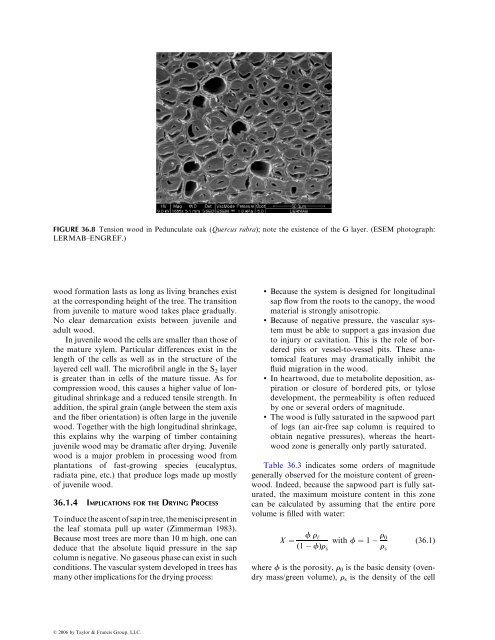s<strong>of</strong>twoods, compression wood is found in the lowerpart. However, the compression wood can also befound in some primitive groups <strong>of</strong> hardwoods (Carlquist,2001).<strong>36</strong>.1.3 .1 Com pression Wo odCompared with normal wood, this tissue is characterizedby shorter tracheids, higher lignin and hemicellulosecontent, and lower cellulose content. Thisreaction wood is easily identified on smooth surfaces,in particular in a transverse view. When compressionwood is formed, the growth rings appear darker,reddish brown, and <strong>of</strong>ten wider than on the oppositeside. Therefore, when compression wood develops inthe same side for several years, the cross section <strong>of</strong> thestem tends to be oval with an eccentric pith in thecore; this is typical <strong>of</strong> branches or stem <strong>of</strong> bent trees.At the anatomical level the cells observed in crosssection are more rounded than rectangular, showinglarge intercellular spaces (Figure <strong>36</strong>.7). The cell wallconsists only <strong>of</strong> ML, P, S 1 , and S 2 layers. Once dry,the cell wall shows deep, helically arranged checksfrom the lumen. The latter is rather thick and itsmicr<strong>of</strong>ibril angle is much larger than in normalwood (about 45 8 from the axial direction). In consequence,the density is higher, the longitudinal shrinkageis increased to some percentage (compared with0.1 to 0.2% for normal wood), and, in spite <strong>of</strong> thehigher density, the longitudinal mechanical propertiesare less than in normal wood. Due to the large micr<strong>of</strong>ibrilangle in the S 2 layer, the effect is opposite in thetransverse plane: lower shrinkage and higher stiffness.<strong>36</strong>.1.3 .2 Te nsion Wo odTension wood is characterized by increased cellulosecontent and increased density. Sawn surfaces appearwoolly and rough. Strength properties are reduced.Longitudinal shrinkage can be more than 1%. Nosignificant coloration marks out tension-wood zones.In addition, the regulation <strong>of</strong> hardwood seems to besubtler than in s<strong>of</strong>twoods, sometimes leading to verylocalized presence <strong>of</strong> reaction wood (thin layers in theradial direction and variable angular position fromone year to the other). Therefore, the macroscopicfeatures are not very reliable.At the microscopic level, tension wood is mucheasier to identify when it is fully developed. Fiber cellwalls are much thicker than normal, enclosing verysmall lumens. Secondary walls are loosely attached tothe primary wall and thus are responsible for some <strong>of</strong>the differing mechanical properties. The thick secondarywall <strong>of</strong> tension-wood fibers is significantly lesserlignified; it consists <strong>of</strong> almost pure cellulose. Due tothis consistency, this layer is termed gelatinous orG layer (Figure <strong>36</strong>.8). The micr<strong>of</strong>ibrils are almostparallel to the grain. The reason for tension-woodshrinkage is not well understood. The loose contactbetween the G layer and the remaining cell wall,which does not restrain the outer cell region (i.e.,primary layer) and from contraction during drying,is one possible explanation. However, a recent worktends to prove that the G layer itself has a highlongitudinal shrinkage, which is not consistent withthe small micr<strong>of</strong>ibril angle (Clair, 2001). It may benoted that intermediate indications <strong>of</strong> tension woodexist without the G layer.<strong>36</strong>.1.3.3 Juvenile <strong>Wood</strong>All trees during their growth produce juvenile wood,i.e., the inner core <strong>of</strong> xylem surrounding the pith.The time during which juvenile wood is formed variesamong individuals, with species, and with environmentalconditions. It is <strong>of</strong>ten recognized that juvenileRTNormal woodCompression woodFIGURE <strong>36</strong>.7 Compression wood compared with normal wood. (ESEM photographs: White fir (Abies alba), LERMAB–ENGREF.)ß 2006 by Taylor & Francis Group, LLC.
FIGURE <strong>36</strong>.8 Tension wood in Pedunculate oak (Quercus rubra); note the existence <strong>of</strong> the G layer. (ESEM photograph:LERMAB–ENGREF.)wood formation lasts as long as living branches existat the corresponding height <strong>of</strong> the tree. The transitionfrom juvenile to mature wood takes place gradually.No clear demarcation exists between juvenile andadult wood.In juvenile wood the cells are smaller than those <strong>of</strong>the mature xylem. Particular differences exist in thelength <strong>of</strong> the cells as well as in the structure <strong>of</strong> thelayered cell wall. The micr<strong>of</strong>ibril angle in the S 2 layeris greater than in cells <strong>of</strong> the mature tissue. As forcompression wood, this causes a higher value <strong>of</strong> longitudinalshrinkage and a reduced tensile strength. Inaddition, the spiral grain (angle between the stem axisand the fiber orientation) is <strong>of</strong>ten large in the juvenilewood. Together with the high longitudinal shrinkage,this explains why the warping <strong>of</strong> timber containingjuvenile wood may be dramatic after drying. Juvenilewood is a major problem in processing wood fromplantations <strong>of</strong> fast-growing species (eucalyptus,radiata pine, etc.) that produce logs made up mostly<strong>of</strong> juvenile wood.<strong>36</strong>.1.4 IMPLICATIONS FOR THE DRYING P ROCESSToinducetheascent<strong>of</strong>sapintree,themeniscipresentinthe leaf stomata pull up water (Zimmerman 1983).Because most trees are more than 10 m high, one candeduce that the absolute liquid pressure in the sapcolumn is negative. No gaseous phase can exist in suchconditions. The vascular system developed in trees hasmany other implications for the drying process:. Because the system is designed for longitudinalsap flow from the roots to the canopy, the woodmaterial is strongly anisotropic.. Because <strong>of</strong> negative pressure, the vascular systemmust be able to support a gas invasion dueto injury or cavitation. This is the role <strong>of</strong> borderedpits or vessel-to-vessel pits. These anatomicalfeatures may dramatically inhibit thefluid migration in the wood.. In heartwood, due to metabolite deposition, aspirationor closure <strong>of</strong> bordered pits, or tylosedevelopment, the permeability is <strong>of</strong>ten reducedby one or several orders <strong>of</strong> magnitude.. The wood is fully saturated in the sapwood part<strong>of</strong> logs (an air-free sap column is required toobtain negative pressures), whereas the heartwoodzone is generally only partly saturated.Table <strong>36</strong>.3 indicates some orders <strong>of</strong> magnitudegenerally observed for the moisture content <strong>of</strong> greenwood.Indeed, because the sapwood part is fully saturated,the maximum moisture content in this zonecan be calculated by assuming that the entire porevolume is filled with water:X ¼ fr ‘(1 f)r swith f ¼ 1r 0r s(<strong>36</strong>:1)where f is the porosity, r 0 is the basic density (ovendrymass/green volume), r s is the density <strong>of</strong> the cellß 2006 by Taylor & Francis Group, LLC.
















